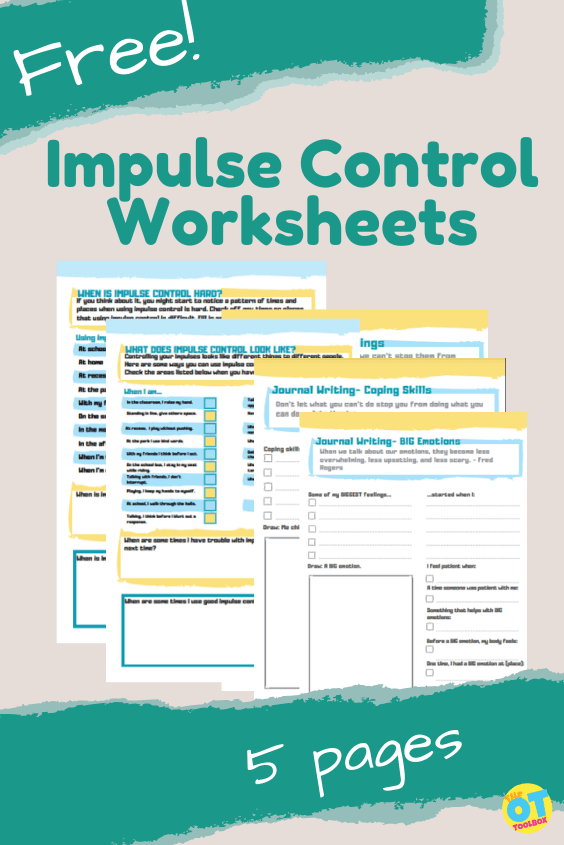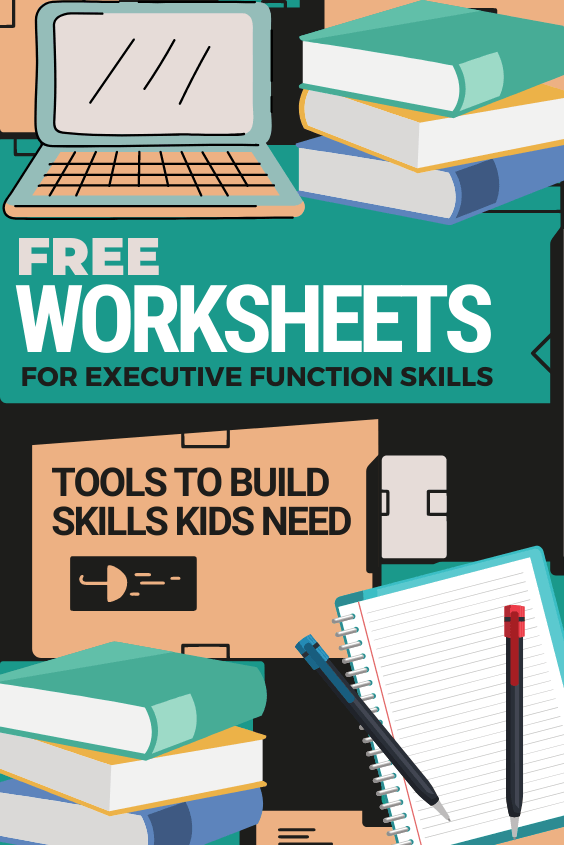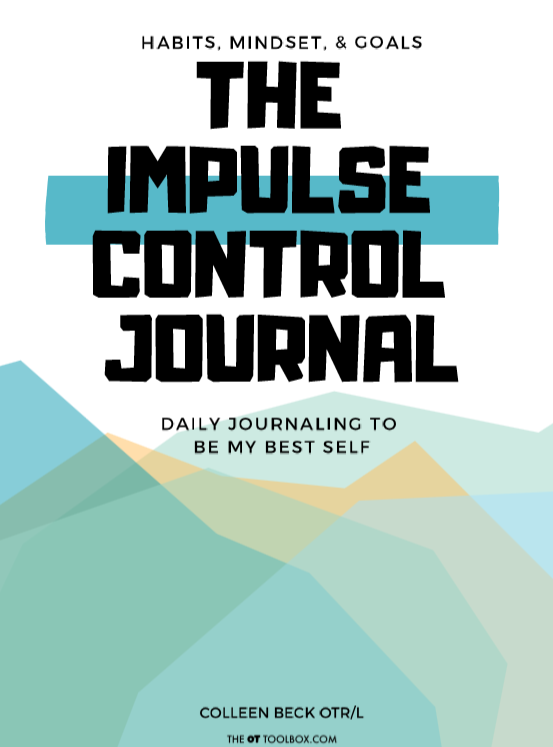This past week, I’ve shared a few impulse control resources and these impulse control resources are just one more tool to add to the toolbox! I wanted to pull out a few of the helpful controlling impulsive behavior worksheets from The Impulse Control Journal to share with you. Use these in isolation, or grab the whole 80 page packet to use to help with areas such as habits, mindset, goal setting, and focusing on addressing impulsive behaviors that impact learning, social emotional learning, and more.
When we equip our clients, students, and patients to stop and think, they can use tactics and cognitive strategies that work to ensure success in daily functional tasks.

Impulse Control Worksheets
These free impulse control worksheets are just a snippet of the materials you’ll find in the Impulse Control Journal.
Included in this sample pack are 5 pages:
- When is Impulse Control Hard
- What Does Impulse Control Look Like Worksheet
- BIG Emotions Journal Writing Page
- Feelings Journal Writing Page
- Coping Skills Journal Writing Page
Each page is printable and you can use them over and over again to target impulsive behaviors and actions.
Use the impulse control worksheets as teaching tools for kids and teens to show how responses to situations, emotions, and mindset impact impulsive actions, and how to use specific coping strategies to allow learning and functioning in situations. When is Impulse Control Hard

When is Impulse Control Hard Worksheet
This page in the packet describes situations when impulse control skills can be difficult. This is important because it helps individuals realize that they are not alone, and that controlling impulsive behaviors isn’t something to be worried about, ashamed of, or that they are the only ones having trouble controlling their impulses.
The worksheet includes a teaching portion: If you think about it, you might start to notice a pattern of times and places when using impulse control is hard.
Users can then check off any times or places that using impulse control is difficult. This can change depending on the day, the situation, emotions, events, etc. Users can also fill in any times not on the list.
Then, the worksheet asks about when using impulse control is easiest and when it is hardest. This is a good exercise to journal and build a toolbox of experiences using working memory. What are some strategies that DID help the user to be safe or make good choices in a a particular situation? What impacted poor choices? These are all areas that can be expanded upon.
What Does Impulse Control Look Like Worksheet
This worksheet helps kids understand what impulse control is and how specific situations can lead to different impulsive behaviors or actions to different people. The executive function worksheet then describes different ways to use impulse control skills in different situaitons. The worksheet allows users to check off different ways they have demonstrated impulse control skills in the past.
This is a great way to teach, but also to build working memory skills. What has worked in the past can be pulled from to use as a tool in the future.
Next, the worksheet asks about times that the individual has used good examples of impulse control. It also asks about specific times or events where poor impulse control was used. This worksheet can be used on a daily or weekly basis to help with working memory in building coping tools for impulse control.
BIG Emotions Journal Writing Page
Another worksheet in the packet is one on BIG emotions. These are the emotions that can be difficult to manage in a way that impacts actions and behaviors. The worksheet includes a quote from Fred Rogers:
“When we talk about our emotions, they become less
-quote by Fred Rogers
overwhelming, less upsetting, and less scary.”
Kids can use the worksheet to journal about their biggest emotions, using the journal prompts. There is also a drawing prompt as well.
The big emotions prompts touch on interoception as well. Interoception, or the sense of the internal state of the body, is a sense that can impact how we “feel” on the inside with big emotions. Sensations connected with emotions might include:
- Butterflies in the stomach
- Heart racing
- Holding your breath
- Breathing fast
- Stomach churning
- “Seeing red”
- Tensed muscles
Here is more information on emotions and interoception. The worksheet asks questions like this because it can help users to connect the dots between big emotions and impulsive actions.
There are also pieces on this worksheet that include concepts of empathy awareness. It asks users to recall times when others may have experienced big emotions. It can be helpful to connect to others and see that impulsive actions are something that everyone deals with at one time or another.
Feelings Journal Writing Page
There is also a feelings worksheet. This worksheet is intended to help users realized that feelings are great to experience, whether they are feelings of happiness, sadness, or anger, etc. Sometimes some of our kiddos might get into a thought process where if they are in a “red zone” (relating to the Zones of Regulation program), they might get it in their head that being in a red zone is a bad thing, when it’s definitely not!
There is a quote by Jonathan Martensson on this worksheet page:
Feelings are much like waves, we can’t stop them from coming, but we can choose which one to surf.
– quote by Jonathan Martensson
The journal page goes on to include writing and drawing prompts about feelings and emotions.
Coping Skills Journal Writing Page
And finally, there is a coping skills worksheet. This page includes writing prompts and a drawing prompt about coping tools that can be used in situations when impulse control might be needed. This worksheet page helps users draw from past experiences and to build their working memory “bucket” of tools they can use in the future. There is also a quote from John Wooden:
Don’t let what you can’t do stop you from doing what you
-quote by John Wooden
can do.
This letter to future self is a great activity to look at what one is doing currently and to identify changes that one wants to achieve. Using those goals as incentive to be a different or changed version supports development. Then, use that future version with a goal ladder to break down the steps to achieve that version.
You may also want to grab the Impulse Control Journal, which is where these worksheets come from. It’s a huge resource designed to develop and strengthen executive functioning skills as well as habit building, goal setting, mindset, and of course, impulse control. I love this journal because it helps kids and teens to recognize their strengths, build upon them, and realize they have the capability to do what they need to do and what they want to do.
The Impulse Control Journal…a printable resource for helping kids strategize executive functioning skill development. When saying “calm down” just isn’t enough…
When a child is easily “triggered” and seems to melt down at any sign of loud noises or excitement…
When you need help or a starting point to teach kids self-regulation strategies…
When you are struggling to motivate or redirect a child without causing a meltdown…
When you’re struggling to help kids explore their emotions, develop self-regulation and coping skills, manage and reflect on their emotions, identify their emotions, and more as they grow…
Grab the Impulse Control Journal to build organizational strategies, planning, prioritization, habits, and mindset in kids.
Free Impulse Control Worksheets
So, what do you think? Would you like to add this printable worksheet set to your therapy toolbox? You’ll need to enter your email address into the form below to access this file.

Colleen Beck, OTR/L has been an occupational therapist since 2000, working in school-based, hand therapy, outpatient peds, EI, and SNF. Colleen created The OT Toolbox to inspire therapists, teachers, and parents with easy and fun tools to help children thrive. Read her story about going from an OT making $3/hour (after paying for kids’ childcare) to a full-time OT resource creator for millions of readers. Want to collaborate? Send an email to contact@theottoolbox.com.







